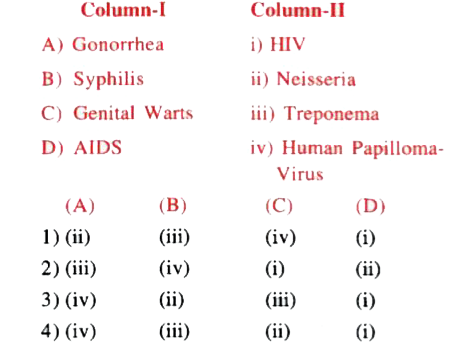Stele includes
1)Endodermis, pericycle, xylem, phloem, cambium, pith and pith rays
2)Pericycle, xylem, phloem, cambium, pith and pith rays
3)Xylem, phloem, cambium, pith and pith rays only
4)Xylem, phloem and cambium only
The correct Answer is:B
Step-by-Step Solution:
1. Understanding the term 'Stele':
- Stele refers to the central part of the root or stem in vascular plants. It is composed of various tissues that are essential for the plant's structure and function.
2. Components of Stele:
- The stele includes several key components:
- Pericycle: A layer of cells that can give rise to lateral roots.
- Xylem: The tissue responsible for water and nutrient transport from roots to other parts of the plant.
- Phloem: The tissue responsible for the transport of sugars and other metabolic products downward from the leaves.
- Cambium: A layer of tissue that produces new xylem and phloem cells, allowing for growth in thickness.
- Cambium rays: These are extensions of the cambium that help in the lateral transport of nutrients and water.
3. Identifying Incorrect Options:
- The question provides four options, and we need to determine which one accurately lists the components of the stele.
- Option 1: Endodermis, pericycle, xylem, phloem, cambium with rays - Incorrect because endodermis is not part of the stele; it is part of the cortex.
- Option 2: Pericycle, xylem, phloem, cambium with rays - Correct as it includes all the essential components of the stele.
- Option 3: Xylem, phloem, cambium with rays only - Incorrect as it omits the pericycle.
- Option 4: Xylem, phloem, cambium only - Incorrect as it also omits the pericycle and does not mention the rays.
4. Conclusion:
- After evaluating all options, the correct answer is Option 2: Pericycle, xylem, phloem, cambium with rays.
---
- Stele refers to the central part of the root or stem in vascular plants. It is composed of various tissues that are essential for the plant's structure and function.
- The stele includes several key components:
- Pericycle: A layer of cells that can give rise to lateral roots.
- Xylem: The tissue responsible for water and nutrient transport from roots to other parts of the plant.
- Phloem: The tissue responsible for the transport of sugars and other metabolic products downward from the leaves.
- Cambium: A layer of tissue that produces new xylem and phloem cells, allowing for growth in thickness.
- Cambium rays: These are extensions of the cambium that help in the lateral transport of nutrients and water.
- The question provides four options, and we need to determine which one accurately lists the components of the stele.
- Option 1: Endodermis, pericycle, xylem, phloem, cambium with rays - Incorrect because endodermis is not part of the stele; it is part of the cortex.
- Option 2: Pericycle, xylem, phloem, cambium with rays - Correct as it includes all the essential components of the stele.
- Option 3: Xylem, phloem, cambium with rays only - Incorrect as it omits the pericycle.
- Option 4: Xylem, phloem, cambium only - Incorrect as it also omits the pericycle and does not mention the rays.
- After evaluating all options, the correct answer is Option 2: Pericycle, xylem, phloem, cambium with rays.
Topper's Solved these Questions
- HISTOLOGY AND ANATOMY OF FLOWERING PLANTSBook:AAKASH SERIESChapter:HISTOLOGY AND ANATOMY OF FLOWERING PLANTSExercise:EXERCISE - I (SECONDARY GROWTH)
Explore 45 Videos
- HISTOLOGY AND ANATOMY OF FLOWERING PLANTSBook:AAKASH SERIESChapter:HISTOLOGY AND ANATOMY OF FLOWERING PLANTSExercise:EXERCISE - II
Explore 214 Videos
- HISTOLOGY AND ANATOMY OF FLOWERING PLANTSBook:AAKASH SERIESChapter:HISTOLOGY AND ANATOMY OF FLOWERING PLANTSExercise:EXERCISE - I (THE TISSUES SYSTEMS)
Explore 41 Videos
- ENVIRONMENTAL ISSUESBook:AAKASH SERIESChapter:ENVIRONMENTAL ISSUESExercise:Exercise-III (Previous AIPMT/NEET Questions)
Explore 41 Videos
- HUMAN HEALTH DISEASEBook:AAKASH SERIESChapter:HUMAN HEALTH DISEASEExercise:EXERCISE - III (PREVIOUS AIPMT/NEET QUESTIONS)
Explore 56 Videos
Similar Questions
Dedifferentiation occurs during the formation of
View SolutionHistogen theory was proposed by
View SolutionGuard cells of stomata are very closely associated with
View SolutionWhich of the following in sewage treatment removes suspended solids?
View SolutionMatch the following sexually transmitted diseases (Colum-I) with their causative agent (Column -II) and select the correct option.

View SolutionStele includes
View SolutionFerm stele is
View SolutionThe composition of stele is
View SolutionStele consits of
View SolutionStele in Selaginella is
View SolutionStele includes pericycle and _________ .
View SolutionStele includes all of these except
View SolutionDefine stele.
View SolutionStele includes
View SolutionStele includes
View SolutionThe stele of a dicot stem includes all,except
View Solution
